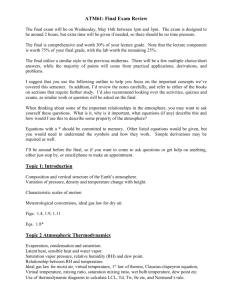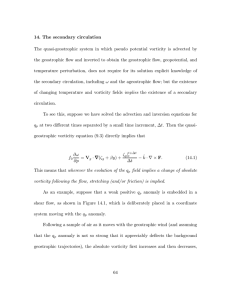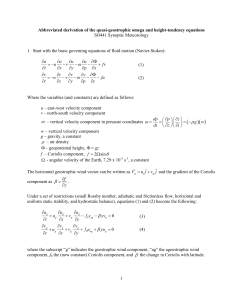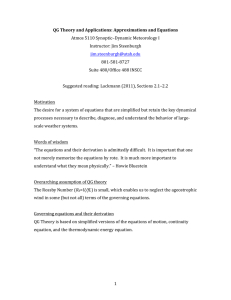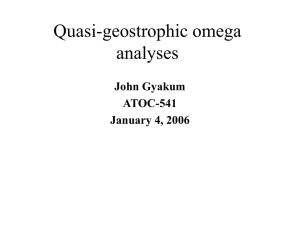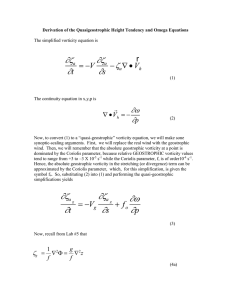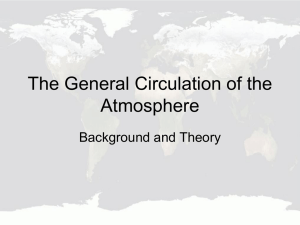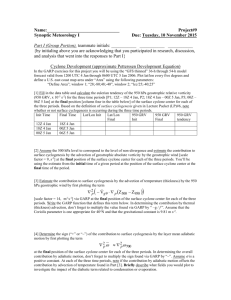Quasigeostrophic Theory: Height Tendency Equation
advertisement
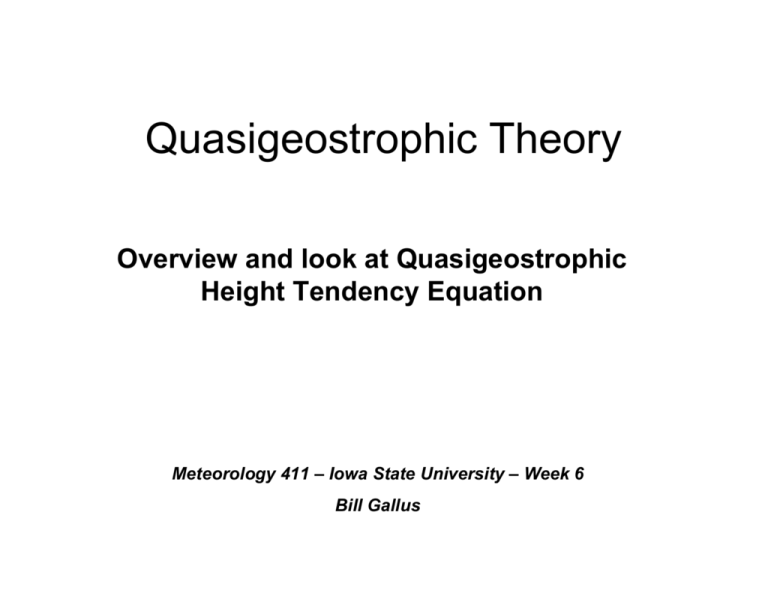
Quasigeostrophic Theory Overview and look at Quasigeostrophic Height Tendency Equation Meteorology 411 – Iowa State University – Week 6 Bill Gallus How do we analyze/predict weather? 1. Conceptual models - “how will cyclone move” – example is Norwegian Cyclone model 2. Kinematic Approach – need to know moisture supply and upward motion 3. Primitive Equation models – e.g. NAM 4. Statistics/Correlations – e.g. MOS Kinematic approach can be very informative and done without computers but pressure tendency and vertical motion (w) must be measured accurately, and this can be difficult. Derivation of QG equations • Consider Vorticity and Thermodynamic Equations • Do we have a predictive equation for vorticty (dζ/dt = ?) • ζ = ∂v/ ∂x - ∂u/ ∂y so we see it depends on u and v, and we do have predictive equations for those. So take d/dt of everything QG Vorticity Equation Local change Horizontal advection Horizontal advection of of earth’s Vertical relative vorticity vorticity advection Divergence term ∂ζ/ ∂t + u∂ζ/∂x + v∂ζ/∂y + vβ = -ω∂ζ/∂p –δζ – δf – (∂v/∂p ∂ω/∂x - ∂u/∂p ∂ω/∂y) + Div term Tilting terms (∂Fy/∂x – ∂Fx/∂y) friction Biggest term is δf but local changes and horizontal adv of zeta, vertical advection and tilting are close seconds QG Thermodynamic Equation ∂T/ ∂t + u∂T/∂x + v∂T/∂y = -ωσp/R + 1/cpdQ/Dt where σ = -T ∂ ln θ/∂p With first term local change, 2nd and 3rd being horizontal advection, 4th being vertical advection and adiabatic effects combined, and last being diabatic term All of these terms may be important Why is it called quasigeostrophic? What does quasi mean? It means “roughly” For small friction, things are nearly geostrophic. We know the divergence terms are very important, but what happens if we assume the wind is geostrophic and use that in the divergence term? Divergence of the geostrophic wind? V Vg = - 1/f ∂Φ/∂x∂y + 1/f ∂Φ/∂x∂y = 0 Do we really want to assume something that would mean there never is any divergence or convergence? QG Equations • So we use the geostrophic wind in our equations everywhere EXCEPT the divergence terms, • We assume the β-plane approximation (so f = f0) since we assume βy is small • We use geostrophic vorticity ζg = ∂vg/ ∂x - ∂ug/ ∂y = 1/f02 V2Φ Geostrophic derivative • We also use a geostrophic version of the derivative term: D/Dt = ∂/∂t + VgV And assume things are frictionless, tilting term is ignored, and geostrophic vorticity is neglected in the divergence term QG Equations ∂ζg/ ∂t + VgVζg+ vgβ = -δf0 (Vort Eq) ∂T/ ∂t + VgVT = ωσp/R (Thermo Eq) But, we can use the definition of ζg and also note that T = p/ρR, and ∂p/∂z = - ρg to see that ρ=-∂p/∂Φ, and thus T = -p/R ∂Φ/∂p We will define ∂Φ/∂t = Χ - Geopotential Height Tendency (chi) Disguise QG Vort and Thermo Equations using Chi • 1/f0V2X = -VgV(ζg+f) + f0∂ω/∂p (Eq. 1) • -P/R∂X/∂p = -VgVT + ωσP/R (Eq. 2) • These can be turned into a single equation for ω (QG omega equation) or for X (QG Height Tendency Equation) QG X Equation • Take f0 (1) + -(f02/σ)∂/∂p(R/p) (2) to get (V2 + f02/σ ∂2/∂p2)X = f0[-VgV(ζg+f)] – f02/σ ∂/∂p( R/p (-VgVT)) – f02ω∂lnσ/∂p Can also add back in effects of friction and diabatic heating, which we excluded so far: + f0(-K ζg) - f02/σ ∂/∂p( R/p(1/cpdQ/dt)) QG X Equation Acts like a minus sign in front of X Term A is advection of absolute geostrophic vorticity (V2 + f02/σ ∂2/∂p2)X = f0[-VgV(ζg+f)] – f02/σ ∂/∂p( R/p (-VgVT)) – f02ω∂lnσ/∂p + f0(-K ζg) - f02/σ ∂/∂p( R/p(1/cpdQ/dt)) Term C is friction Term B is differential temperature advection Term D is diabatic term Usually close to 0 Notes • 1/p in both terms relating to temperature means forcing is more efficient aloft • 1/σ in the temperature terms means more impact in an unstable (less stable) atmosphere Interpretations • PVA would mean term A is positive and thus X would have to be negative Æ heights fall (opposite is true for NVA) • Warm Air Advection (WAA) usually is greatest near the ground and less aloft, so term B would be negative, and X would have to be positive Æ so heights rise (opposite is true for Cold Air Advection) Interpretations • Friction acts to oppose what is going on, so if we have cyclonic rotation, term C is negative, and X would have to be positive, and heights would rise (filling the low) • Diabatic heating maximized near the ground would make term D negative, and X would be positive, so heights would rise
